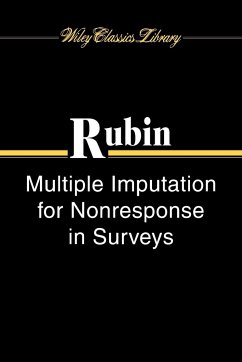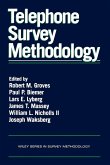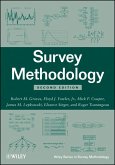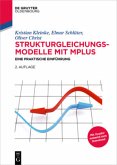Donald B. Rubin
Multiple Imputation for Nonresponse in Surveys
Donald B. Rubin
Multiple Imputation for Nonresponse in Surveys
- Broschiertes Buch
- Merkliste
- Auf die Merkliste
- Bewerten Bewerten
- Teilen
- Produkt teilen
- Produkterinnerung
- Produkterinnerung
Demonstrates how nonresponse in sample surveys and censuses can be handled by replacing each missing value with two or more multiple imputations. Clearly illustrates the advantages of modern computing to such handle surveys, and demonstrates the benefit of this statistical technique for researchers who must analyze them. Also presents the background for Bayesian and frequentist theory. After establishing that only standard complete-data methods are needed to analyze a multiply-imputed set, the text evaluates procedures in general circumstances, outlining specific procedures for creating…mehr
Andere Kunden interessierten sich auch für
![Modern Survey Interview Modern Survey Interview]() Modern Survey Interview153,99 €
Modern Survey Interview153,99 €![Telephone Survey Methodology Telephone Survey Methodology]() Robert M. Groves / Paul P. Biemer / Lars E. Lyberg / James T. Massey / William L. Nicholls / Joseph Waksberg (Hgg.)Telephone Survey Methodology147,99 €
Robert M. Groves / Paul P. Biemer / Lars E. Lyberg / James T. Massey / William L. Nicholls / Joseph Waksberg (Hgg.)Telephone Survey Methodology147,99 €![Survey Methodology Survey Methodology]() Eleanor SingerSurvey Methodology101,99 €
Eleanor SingerSurvey Methodology101,99 €![Telefonbefragungen über das Mobilfunknetz Telefonbefragungen über das Mobilfunknetz]() Michael Häder / Sabine Häder (Hrsg.)Telefonbefragungen über das Mobilfunknetz49,99 €
Michael Häder / Sabine Häder (Hrsg.)Telefonbefragungen über das Mobilfunknetz49,99 €![Empirische Sozialforschung Empirische Sozialforschung]() Helmut KromreyEmpirische Sozialforschung36,90 €
Helmut KromreyEmpirische Sozialforschung36,90 €![Strukturgleichungsmodelle mit Mplus Strukturgleichungsmodelle mit Mplus]() Kristian KleinkeStrukturgleichungsmodelle mit Mplus34,95 €
Kristian KleinkeStrukturgleichungsmodelle mit Mplus34,95 €![Quantitative Social Science Quantitative Social Science]() Kosuke ImaiQuantitative Social Science120,99 €
Kosuke ImaiQuantitative Social Science120,99 €-
-
-
Demonstrates how nonresponse in sample surveys and censuses can be handled by replacing each missing value with two or more multiple imputations. Clearly illustrates the advantages of modern computing to such handle surveys, and demonstrates the benefit of this statistical technique for researchers who must analyze them. Also presents the background for Bayesian and frequentist theory. After establishing that only standard complete-data methods are needed to analyze a multiply-imputed set, the text evaluates procedures in general circumstances, outlining specific procedures for creating imputations in both the ignorable and nonignorable cases. Examples and exercises reinforce ideas, and the interplay of Bayesian and frequentist ideas presents a unified picture of modern statistics.
Produktdetails
- Produktdetails
- Wiley Classics Library
- Verlag: Wiley & Sons
- 1. Auflage
- Seitenzahl: 320
- Erscheinungstermin: 1. Mai 2004
- Englisch
- Abmessung: 234mm x 156mm x 18mm
- Gewicht: 455g
- ISBN-13: 9780471655749
- ISBN-10: 0471655740
- Artikelnr.: 12964722
- Herstellerkennzeichnung
- Libri GmbH
- Europaallee 1
- 36244 Bad Hersfeld
- gpsr@libri.de
- Wiley Classics Library
- Verlag: Wiley & Sons
- 1. Auflage
- Seitenzahl: 320
- Erscheinungstermin: 1. Mai 2004
- Englisch
- Abmessung: 234mm x 156mm x 18mm
- Gewicht: 455g
- ISBN-13: 9780471655749
- ISBN-10: 0471655740
- Artikelnr.: 12964722
- Herstellerkennzeichnung
- Libri GmbH
- Europaallee 1
- 36244 Bad Hersfeld
- gpsr@libri.de
Donald B. Rubin , PhD, is a John L. Loeb Professor of Statistics at Harvard University in Cambridge, MA. He was named 2000-2001 Statistician of the Year by the Chicago Chapter of ASA. His research interests include causal inference in experiments and observational studies, developing and applying statistical models to data in a variety of scientific disciplines, and the application of Bayesian and empirical Bayesian techniques.
Tables and Figures.
Glossary.
1. Introduction.
1.1 Overview.
1.2 Examples of Surveys with Nonresponse.
1.3 Properly Handling Nonresponse.
1.4 Single Imputation.
1.5 Multiple Imputation.
1.6 Numerical Example Using Multiple Imputation.
1.7 Guidance for the Reader.
2. Statistical Background.
2.1 Introduction.
2.2 Variables in the Finite Population.
2.3 Probability Distributions and Related Calculations.
2.4 Probability Specifications for Indicator Variables.
2.5 Probability Specifications for (X,Y).
2.6 Bayesian Inference for a Population Quality.
2.7 Interval Estimation.
2.8 Bayesian Procedures for Constructing Interval Estimates, Including
Significance Levels and Point Estimates.
2.9 Evaluating the Performance of Procedures.
2.10 Similarity of Bayesian and Randomization-Based Inferences in Many
Practical Cases.
3. Underlying Bayesian Theory.
3.1 Introduction and Summary of Repeated-Imputation Inferences.
3.2 Key Results for Analysis When the Multiple Imputations are Repeated
Draws from the Posterior Distribution of the Missing Values.
3.3 Inference for Scalar Estimands from a Modest Number of Repeated
Completed-Data Means and Variances.
3.4 Significance Levels for Multicomponent Estimands from a Modest Number
of Repeated Completed-Data Means and Variance-Covariance Matrices.
3.5 Significance Levels from Repeated Completed-Data Significance Levels.
3.6 Relating the Completed-Data and Completed-Data Posterior Distributions
When the Sampling Mechanism is Ignorable.
4. Randomization-Based Evaluations.
4.1 Introduction.
4.2 General Conditions for the Randomization-Validity of Infinite-m
Repeated-Imputation Inferences.
4.3Examples of Proper and Improper Imputation Methods in a Simple Case with
Ignorable Nonresponse.
4.4 Further Discussion of Proper Imputation Methods.
4.5 The Asymptotic Distibution of (&Qmacr;m,Ūm,Bm) for Proper
Imputation Methods.
4.6 Evaluations of Finite-m Inferences with Scalar Estimands.
4.7 Evaluation of Significance Levels from the Moment-Based Statistics Dm
and &Dtilde;m with Multicomponent Estimands.
4.8 Evaluation of Significance Levels Based on Repeated Significance
Levels.
5. Procedures with Ignorable Nonresponse.
5.1 Introduction.
5.2 Creating Imputed Values under an Explicit Model.
5.3 Some Explicit Imputation Models with Univariate YI and Covariates.
5.4 Monotone Patterns of Missingness in Multivariate YI.
5.5 Missing Social Security Benefits in the Current Population Survey.
5.6 Beyond Monotone Missingness.
6. Procedures with Nonignorable Nonresponse.
6.1 Introduction.
6.2 Nonignorable Nonresponse with Univariate YI and No XI.
6.3 Formal Tasks with Nonignorable Nonresponse.
6.4 Illustrating Mixture Modeling Using Educational Testing Service Data.
6.5 Illustrating Selection Modeling Using CPS Data.
6.6 Extensions to Surveys with Follow-Ups.
6.7 Follow-Up Response in a Survey of Drinking Behavior Among Men of
Retirement Age.
References.
Author Index.
Subject Index.
Appendix I. Report Written for the Social Security Administration in 1977.
Appendix II. Report Written for the Census Bureau in 1983.
Glossary.
1. Introduction.
1.1 Overview.
1.2 Examples of Surveys with Nonresponse.
1.3 Properly Handling Nonresponse.
1.4 Single Imputation.
1.5 Multiple Imputation.
1.6 Numerical Example Using Multiple Imputation.
1.7 Guidance for the Reader.
2. Statistical Background.
2.1 Introduction.
2.2 Variables in the Finite Population.
2.3 Probability Distributions and Related Calculations.
2.4 Probability Specifications for Indicator Variables.
2.5 Probability Specifications for (X,Y).
2.6 Bayesian Inference for a Population Quality.
2.7 Interval Estimation.
2.8 Bayesian Procedures for Constructing Interval Estimates, Including
Significance Levels and Point Estimates.
2.9 Evaluating the Performance of Procedures.
2.10 Similarity of Bayesian and Randomization-Based Inferences in Many
Practical Cases.
3. Underlying Bayesian Theory.
3.1 Introduction and Summary of Repeated-Imputation Inferences.
3.2 Key Results for Analysis When the Multiple Imputations are Repeated
Draws from the Posterior Distribution of the Missing Values.
3.3 Inference for Scalar Estimands from a Modest Number of Repeated
Completed-Data Means and Variances.
3.4 Significance Levels for Multicomponent Estimands from a Modest Number
of Repeated Completed-Data Means and Variance-Covariance Matrices.
3.5 Significance Levels from Repeated Completed-Data Significance Levels.
3.6 Relating the Completed-Data and Completed-Data Posterior Distributions
When the Sampling Mechanism is Ignorable.
4. Randomization-Based Evaluations.
4.1 Introduction.
4.2 General Conditions for the Randomization-Validity of Infinite-m
Repeated-Imputation Inferences.
4.3Examples of Proper and Improper Imputation Methods in a Simple Case with
Ignorable Nonresponse.
4.4 Further Discussion of Proper Imputation Methods.
4.5 The Asymptotic Distibution of (&Qmacr;m,Ūm,Bm) for Proper
Imputation Methods.
4.6 Evaluations of Finite-m Inferences with Scalar Estimands.
4.7 Evaluation of Significance Levels from the Moment-Based Statistics Dm
and &Dtilde;m with Multicomponent Estimands.
4.8 Evaluation of Significance Levels Based on Repeated Significance
Levels.
5. Procedures with Ignorable Nonresponse.
5.1 Introduction.
5.2 Creating Imputed Values under an Explicit Model.
5.3 Some Explicit Imputation Models with Univariate YI and Covariates.
5.4 Monotone Patterns of Missingness in Multivariate YI.
5.5 Missing Social Security Benefits in the Current Population Survey.
5.6 Beyond Monotone Missingness.
6. Procedures with Nonignorable Nonresponse.
6.1 Introduction.
6.2 Nonignorable Nonresponse with Univariate YI and No XI.
6.3 Formal Tasks with Nonignorable Nonresponse.
6.4 Illustrating Mixture Modeling Using Educational Testing Service Data.
6.5 Illustrating Selection Modeling Using CPS Data.
6.6 Extensions to Surveys with Follow-Ups.
6.7 Follow-Up Response in a Survey of Drinking Behavior Among Men of
Retirement Age.
References.
Author Index.
Subject Index.
Appendix I. Report Written for the Social Security Administration in 1977.
Appendix II. Report Written for the Census Bureau in 1983.
Tables and Figures.
Glossary.
1. Introduction.
1.1 Overview.
1.2 Examples of Surveys with Nonresponse.
1.3 Properly Handling Nonresponse.
1.4 Single Imputation.
1.5 Multiple Imputation.
1.6 Numerical Example Using Multiple Imputation.
1.7 Guidance for the Reader.
2. Statistical Background.
2.1 Introduction.
2.2 Variables in the Finite Population.
2.3 Probability Distributions and Related Calculations.
2.4 Probability Specifications for Indicator Variables.
2.5 Probability Specifications for (X,Y).
2.6 Bayesian Inference for a Population Quality.
2.7 Interval Estimation.
2.8 Bayesian Procedures for Constructing Interval Estimates, Including
Significance Levels and Point Estimates.
2.9 Evaluating the Performance of Procedures.
2.10 Similarity of Bayesian and Randomization-Based Inferences in Many
Practical Cases.
3. Underlying Bayesian Theory.
3.1 Introduction and Summary of Repeated-Imputation Inferences.
3.2 Key Results for Analysis When the Multiple Imputations are Repeated
Draws from the Posterior Distribution of the Missing Values.
3.3 Inference for Scalar Estimands from a Modest Number of Repeated
Completed-Data Means and Variances.
3.4 Significance Levels for Multicomponent Estimands from a Modest Number
of Repeated Completed-Data Means and Variance-Covariance Matrices.
3.5 Significance Levels from Repeated Completed-Data Significance Levels.
3.6 Relating the Completed-Data and Completed-Data Posterior Distributions
When the Sampling Mechanism is Ignorable.
4. Randomization-Based Evaluations.
4.1 Introduction.
4.2 General Conditions for the Randomization-Validity of Infinite-m
Repeated-Imputation Inferences.
4.3Examples of Proper and Improper Imputation Methods in a Simple Case with
Ignorable Nonresponse.
4.4 Further Discussion of Proper Imputation Methods.
4.5 The Asymptotic Distibution of (&Qmacr;m,Ūm,Bm) for Proper
Imputation Methods.
4.6 Evaluations of Finite-m Inferences with Scalar Estimands.
4.7 Evaluation of Significance Levels from the Moment-Based Statistics Dm
and &Dtilde;m with Multicomponent Estimands.
4.8 Evaluation of Significance Levels Based on Repeated Significance
Levels.
5. Procedures with Ignorable Nonresponse.
5.1 Introduction.
5.2 Creating Imputed Values under an Explicit Model.
5.3 Some Explicit Imputation Models with Univariate YI and Covariates.
5.4 Monotone Patterns of Missingness in Multivariate YI.
5.5 Missing Social Security Benefits in the Current Population Survey.
5.6 Beyond Monotone Missingness.
6. Procedures with Nonignorable Nonresponse.
6.1 Introduction.
6.2 Nonignorable Nonresponse with Univariate YI and No XI.
6.3 Formal Tasks with Nonignorable Nonresponse.
6.4 Illustrating Mixture Modeling Using Educational Testing Service Data.
6.5 Illustrating Selection Modeling Using CPS Data.
6.6 Extensions to Surveys with Follow-Ups.
6.7 Follow-Up Response in a Survey of Drinking Behavior Among Men of
Retirement Age.
References.
Author Index.
Subject Index.
Appendix I. Report Written for the Social Security Administration in 1977.
Appendix II. Report Written for the Census Bureau in 1983.
Glossary.
1. Introduction.
1.1 Overview.
1.2 Examples of Surveys with Nonresponse.
1.3 Properly Handling Nonresponse.
1.4 Single Imputation.
1.5 Multiple Imputation.
1.6 Numerical Example Using Multiple Imputation.
1.7 Guidance for the Reader.
2. Statistical Background.
2.1 Introduction.
2.2 Variables in the Finite Population.
2.3 Probability Distributions and Related Calculations.
2.4 Probability Specifications for Indicator Variables.
2.5 Probability Specifications for (X,Y).
2.6 Bayesian Inference for a Population Quality.
2.7 Interval Estimation.
2.8 Bayesian Procedures for Constructing Interval Estimates, Including
Significance Levels and Point Estimates.
2.9 Evaluating the Performance of Procedures.
2.10 Similarity of Bayesian and Randomization-Based Inferences in Many
Practical Cases.
3. Underlying Bayesian Theory.
3.1 Introduction and Summary of Repeated-Imputation Inferences.
3.2 Key Results for Analysis When the Multiple Imputations are Repeated
Draws from the Posterior Distribution of the Missing Values.
3.3 Inference for Scalar Estimands from a Modest Number of Repeated
Completed-Data Means and Variances.
3.4 Significance Levels for Multicomponent Estimands from a Modest Number
of Repeated Completed-Data Means and Variance-Covariance Matrices.
3.5 Significance Levels from Repeated Completed-Data Significance Levels.
3.6 Relating the Completed-Data and Completed-Data Posterior Distributions
When the Sampling Mechanism is Ignorable.
4. Randomization-Based Evaluations.
4.1 Introduction.
4.2 General Conditions for the Randomization-Validity of Infinite-m
Repeated-Imputation Inferences.
4.3Examples of Proper and Improper Imputation Methods in a Simple Case with
Ignorable Nonresponse.
4.4 Further Discussion of Proper Imputation Methods.
4.5 The Asymptotic Distibution of (&Qmacr;m,Ūm,Bm) for Proper
Imputation Methods.
4.6 Evaluations of Finite-m Inferences with Scalar Estimands.
4.7 Evaluation of Significance Levels from the Moment-Based Statistics Dm
and &Dtilde;m with Multicomponent Estimands.
4.8 Evaluation of Significance Levels Based on Repeated Significance
Levels.
5. Procedures with Ignorable Nonresponse.
5.1 Introduction.
5.2 Creating Imputed Values under an Explicit Model.
5.3 Some Explicit Imputation Models with Univariate YI and Covariates.
5.4 Monotone Patterns of Missingness in Multivariate YI.
5.5 Missing Social Security Benefits in the Current Population Survey.
5.6 Beyond Monotone Missingness.
6. Procedures with Nonignorable Nonresponse.
6.1 Introduction.
6.2 Nonignorable Nonresponse with Univariate YI and No XI.
6.3 Formal Tasks with Nonignorable Nonresponse.
6.4 Illustrating Mixture Modeling Using Educational Testing Service Data.
6.5 Illustrating Selection Modeling Using CPS Data.
6.6 Extensions to Surveys with Follow-Ups.
6.7 Follow-Up Response in a Survey of Drinking Behavior Among Men of
Retirement Age.
References.
Author Index.
Subject Index.
Appendix I. Report Written for the Social Security Administration in 1977.
Appendix II. Report Written for the Census Bureau in 1983.









